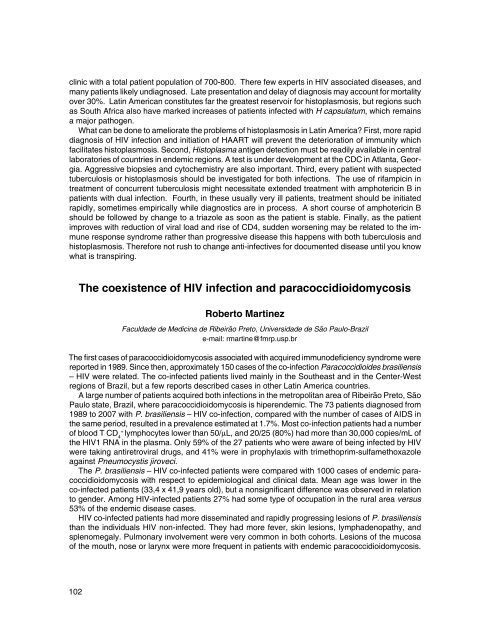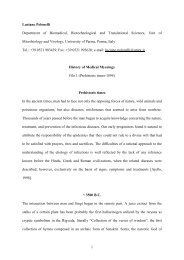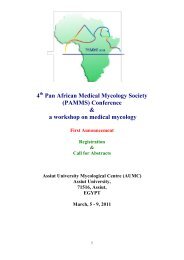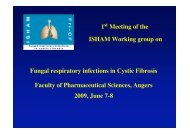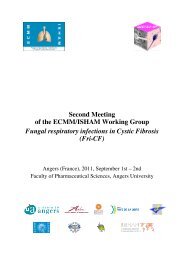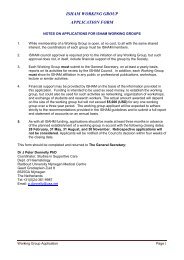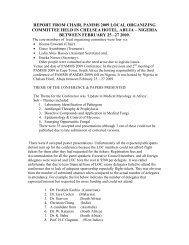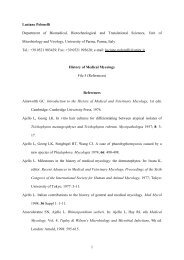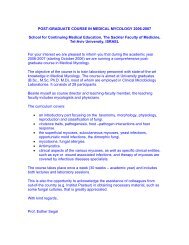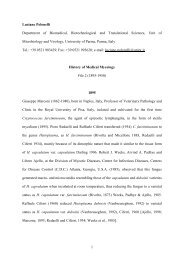Memoria CD.indd - ISHAM
Memoria CD.indd - ISHAM
Memoria CD.indd - ISHAM
Create successful ePaper yourself
Turn your PDF publications into a flip-book with our unique Google optimized e-Paper software.
clinic with a total patient population of 700-800. There few experts in HIV associated diseases, andmany patients likely undiagnosed. Late presentation and delay of diagnosis may account for mortalityover 30%. Latin American constitutes far the greatest reservoir for histoplasmosis, but regions suchas South Africa also have marked increases of patients infected with H capsulatum, which remainsa major pathogen.What can be done to ameliorate the problems of histoplasmosis in Latin America? First, more rapiddiagnosis of HIV infection and initiation of HAART will prevent the deterioration of immunity whichfacilitates histoplasmosis. Second, Histoplasma antigen detection must be readily available in centrallaboratories of countries in endemic regions. A test is under development at the <strong>CD</strong>C in Atlanta, Georgia.Aggressive biopsies and cytochemistry are also important. Third, every patient with suspectedtuberculosis or histoplasmosis should be investigated for both infections. The use of rifampicin intreatment of concurrent tuberculosis might necessitate extended treatment with amphotericin B inpatients with dual infection. Fourth, in these usually very ill patients, treatment should be initiatedrapidly, sometimes empirically while diagnostics are in process. A short course of amphotericin Bshould be followed by change to a triazole as soon as the patient is stable. Finally, as the patientimproves with reduction of viral load and rise of <strong>CD</strong>4, sudden worsening may be related to the immuneresponse syndrome rather than progressive disease this happens with both tuberculosis andhistoplasmosis. Therefore not rush to change anti-infectives for documented disease until you knowwhat is transpiring.The coexistence of HIV infection and paracoccidioidomycosisRoberto MartinezFaculdade de Medicina de Ribeirão Preto, Universidade de São Paulo-Brazile-mail: rmartine@fmrp.usp.brThe first cases of paracoccidioidomycosis associated with acquired immunodeficiency syndrome werereported in 1989. Since then, approximately 150 cases of the co-infection Paracoccidioides brasiliensis– HIV were related. The co-infected patients lived mainly in the Southeast and in the Center-Westregions of Brazil, but a few reports described cases in other Latin America countries.A large number of patients acquired both infections in the metropolitan area of Ribeirão Preto, SãoPaulo state, Brazil, where paracoccidioidomycosis is hiperendemic. The 73 patients diagnosed from1989 to 2007 with P. brasiliensis – HIV co-infection, compared with the number of cases of AIDS inthe same period, resulted in a prevalence estimated at 1.7%. Most co-infection patients had a numberof blood T <strong>CD</strong> 4+lymphocytes lower than 50/µL, and 20/25 (80%) had more than 30,000 copies/mL ofthe HIV1 RNA in the plasma. Only 59% of the 27 patients who were aware of being infected by HIVwere taking antiretroviral drugs, and 41% were in prophylaxis with trimethoprim-sulfamethoxazoleagainst Pneumocystis jiroveci.The P. brasiliensis – HIV co-infected patients were compared with 1000 cases of endemic paracoccidioidomycosiswith respect to epidemiological and clinical data. Mean age was lower in theco-infected patients (33,4 x 41,9 years old), but a nonsignificant difference was observed in relationto gender. Among HIV-infected patients 27% had some type of occupation in the rural area versus53% of the endemic disease cases.HIV co-infected patients had more disseminated and rapidly progressing lesions of P. brasiliensisthan the individuals HIV non-infected. They had more fever, skin lesions, lymphadenopathy, andsplenomegaly. Pulmonary involvement were very common in both cohorts. Lesions of the mucosaof the mouth, nose or larynx were more frequent in patients with endemic paracoccidioidomycosis.102


